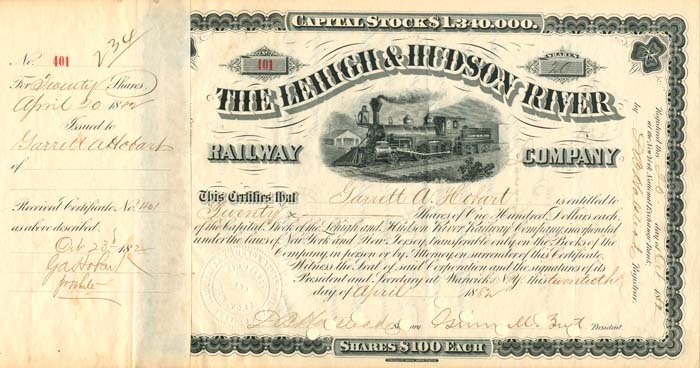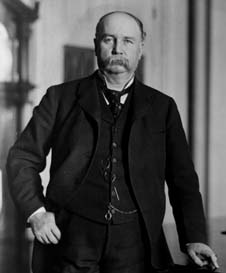Lehigh and Hudson River Railway Co. Issued to and Signed by Garrett A. Hobart - Stock Certificate
Inv# AG1750 Stock
Stock issued to and signed by Garrett A. Hobart on stub. Warwick, New York. Portrait and biography included.
The 24th Vice President of the United States. He was born in Long Branch, New Jersey, and grew up in Marlboro Township. He graduated from Rutgers College in 1863. Although the nation was deeply engaged in the Civil War, Hobart did not join the Union army. Instead, he studied law in Paterson, New Jersey, under the tutelage of Socrates Tuttle, a childhood friend of his father's. He became a lawyer in 1866, and on July 21, 1869, married Tuttle's daughter, Jennie. Hobart's family had long been Democrats, but marriage into the Republican Tuttle household converted the young man to the Grand Old Party. Hobart served in the New Jersey General Assembly from 1872 to 1876, serving as speaker in 1874. He was a member of the New Jersey Senate from 1876 to 1882, serving as its president in 1881. It seems startling that someone who never held prior office outside of a state legislature could be nominated and elected Vice President of the United States, as was Garret Augustus Hobart in 1896. By the time convention delegates chose the last nineteenth-century vice president, they had come to regard that office as little more than a "fifth wheel to the executive coach." The nomination was in their view simply a device for balancing the ticket, either by ideology or by region. "Gus" Hobart, an easterner chosen to run with a middle westerner, William McKinley of Ohio, completely shared McKinley's conservative political philosophy. With warm feelings for Hobart, President McKinley decided to rescue the vice-presidency from its low estate. McKinley so embraced the vice president as his friend, associate, and confidant that Hobart's home on Lafayette Square became known as the "Little Cream White House," and Hobart as the "Assistant President."
The success of Mr. Hobart in politics is largely due to a geniality and bonhommie of nature rarely met with, and to a large-heartedness and generosity, which gave him a personal following perhaps equalled by no public man in the State. Mr. Hobart’s capacity for business had led others to seek his aid in the organization and development of perhaps more corporate and private enterprises than any other citizen of New Jersey, and with many of these he was connected, either as counsel, director or in some other capacity more or less responsible and active. He was president of The Passaic Water Company, supplying the city of Paterson; The Acquackanonk Water Co.,supplying the city of Passaic; The Morris County Railroad, and The Patterson Electric Railway; a director of The Dundee Water Power & Land Co, The New York, Susquehanna & Western Railroad, and The Lehigh & Hudson River Railroad, The First National Bank of Paterson, The Paterson Savings Institution, The Liberty National Bank of the city of New York, The Barbour Flax Spinning Co., The Barbour Bro’s Co., The Pioneer Silk Co., The People’s Gas Light Co., The Passaic Gas Light Co., The Patterson Electric Light Co., The American Cotton Oil Co. of the city of New York, and The Citizens’ Insurance Co. of the same city. The Long Branch Water Co. and The Highland Water Co.; counsel for the East Jersey Water Co., The West Milford Water Storage Co., The Montclair Water Co., and other allied interests; treasurer of The Cedar Lawn Cemetery Co. of Paterson, and of several land companies; and was president or director in a least a score of other corporations, doing business in New Jersey and elsewhere. Some of Mr. Hobart’s most notable achievements have been the discharge of the trusts of receiver of The New Jersey Midland Railroad, The Montclair Railroad, The Jersey City & Albany Railroad, and The First National Bank of Newark, in 1880. The last named important work was done with an energy and ability, which drew from the Comptroller of the Currency the warmest expressions of approval, the complicated business being wound up and the depositors paid in full inside of six months.

The Lehigh and Hudson River Railway (L&HR) was the smallest of the six railroads that were merged into Conrail in 1976. It was a bridge line running northeast–southwest across northwestern New Jersey, connecting the line to the Poughkeepsie Bridge at Maybrook, New York with Easton, Pennsylvania, where it interchanged with various other companies.
The Warwick Valley Railroad was organized March 8, 1860 as a branch of the New York and Erie Rail Road, branching from it at Greycourt southwest to Warwick, New York. It opened in 1862 and was operated by the Erie.
The Pequest and Wallkill Railroad was chartered by 1870 to build an extension in New Jersey, running from Belvidere on the Delaware River and Belvidere Delaware Railroad northeast to the New York state line. The Lehigh and Hudson River Railroad was chartered later as a competitor, planning to build from Belvidere to McAfee, with the Wawayanda Railroad running the rest of the way to the state line. In April/May 1881, the three companies merged to form a new Lehigh and Hudson River Railroad and on April 1, 1882, the Warwick Valley Railroad joined, forming the Lehigh and Hudson River Railway (L&HR).
In the meantime, the Sussex Railroad had built a branch from Hamburg to South Vernon (McAfee); the L&HR bought this around 1881. The Warwick Valley Railroad had built an extension southwest to McAfee in March 1880, and the full line opened August 14, 1882, connecting Belvidere, New Jersey to Greycourt, New York.
The Orange County Railroad was chartered on November 28, 1888 and opened the following year, extending the line northeast from Greycourt to Maybrook. At Maybrook, the line junctioned with the Central New England Railway, continuing east via the Poughkeepsie Bridge over the Hudson River to New England. Trackage rights were obtained over a short piece of the New York, Ontario and Western Railway from the junction at Burnside west to the major junction at Campbell Hall.
The South Easton and Phillipsburg Railroad of New Jersey, and the South Easton and Phillipsburg Railroad of Pennsylvania was organized on July 25, 1889 to build a bridge over the Delaware River between Easton, Pennsylvania and Phillipsburg, New Jersey. The former built 460' on the New Jersey side, while the latter built 850' on the Pennsylvania side. Bridge construction began on November 19, 1889, and concluded the following year on October 2. "The South Easton and Phillipsburg Railroad of New Jersey and South Easton and Phillipsburg of Pennsylvania were consolidated with the Lehigh and Hudson River Railway on April 2, 1912. Subsequently, the L&HR obtained trackage rights over 13 miles of the Pennsylvania Railroad's (PRR) Belvidere Delaware Railroad between Phillipsburg and Belvidere;once the bridge was completed, the L&HR had a continuous line from Maybrook to Easton. At Easton, an interchange could be made with the Central Railroad of New Jersey and Lehigh Valley Railroad, while interchange with the PRR was at Phillipsburg.
The L&HR eventually obtained trackage rights over the Delaware, Lackawanna and Western Railroad's (DL&W) Sussex Railroad from the junction at Andover south to Port Morris, where it interchanged with the main line of the DL&W.
The Mine Hill Railroad was the only branch built. It ran south from a junction at Franklin, New Jersey to the mines of the New Jersey Zinc Company at Sterling Hill, New Jersey.
From October 1912 until January 1916, the L&HR hosted the PRR's Federal Express passenger trains on the Poughkeepsie Bridge Route between Phillipsburg and Maybrook. With the completion of the Hell Gate Bridge in New York City on September 9, 1917, the Federal Express resumed service via Penn Station and the New Haven Line direct. At its peak, L&HR stretched 86 miles between Easton and Maybrook, acting as a bridge line and hauling anthracite coal from a number of mines along its system.
The L&HR filed for Chapter 77 bankruptcy on April 19, 1972, partly due to Penn Central's decision to operate over other routes in order to avoid the aging Poughkeepsie Bridge.
Post-bankruptcy, the L&HR continued to operate a nocturnal daily freight. During the mid-1970s, the L&HR became part of a proposal to run "Bunny Ski Trains" between Hoboken, New Jersey, and the Playboy Resort (Great Gorge) in Vernon, New Jersey. The proposed service, which would have run on weekends during the winter, would have retrieved passengers westbound along the Erie Lackawanna Railway's (EL) Morristown Line to Netcong, New Jersey, then run along a short section of the remaining Sussex Branch to Andover Junction in Andover, New Jersey, and then northbound along the L&HR to the Playboy Club. The service would have utilized EL's new commuter consists, but was met with stiff opposition from EL management, which was anticipating a merger with other northeastern US railroads and did not want to enter into a venture that it viewed as a potential money-loser. The Bunny Ski Train remained a viable proposal until the remaining vestige of the Sussex Branch was removed in July 1977, after it became clear that it was no longer needed as a connector to the L&HR.
As such, in 1976 the L&HR was merged into Conrail. Subsequently, the section between Belvidere, New Jersey and Sparta, New Jersey (Sparta Junction) was abandoned. The tracks, however, remained in place until approximately 1988, when the right-of-way between these two points was acquired by land developer Gerald Turco from Conrail. Turco had also acquired most of the Lackawanna Cut-Off as part of the same deal. Conrail removed the tracks south of Sparta Junction; however, the section north of that point was already being considered by the New York, Susquehanna & Western (NYS&W) as part of a combined regional freight route with Norfolk Southern Railway (NS). The line from Warwick to Campbell Hall, New York is currently leased to the Middletown and New Jersey Railroad.
In New Jersey, the NYS&W owns the L&HR line north of Sparta to the state line. North of the state line, it is owned by NS which had acquired the line during the breakup of Conrail. Both portions of the line are leased to and operated by the Middletown and New Jersey Railroad.
A stock certificate is issued by businesses, usually companies. A stock is part of the permanent finance of a business. Normally, they are never repaid, and the investor can recover his/her money only by selling to another investor. Most stocks, or also called shares, earn dividends, at the business's discretion, depending on how well it has traded. A stockholder or shareholder is a part-owner of the business that issued the stock certificates.









Ebay ID: labarre_galleries